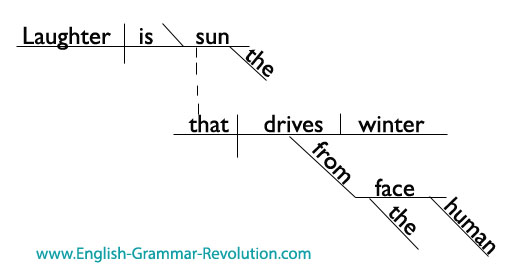You can observe a lot just by watching.
– Yogi Berra
In his discussion of the use of Critical Friends Group protocols with student work, Sam Chaltain explains the process as a chance to look more closely at what students have created. Rather than looking for what the teacher was hoping would come from an assignment, CFG protocols take a step back to ask what the student was doing, creating and attempting in the completion of an assignment.
It turns out you don’t need a protocol to be reminded we need to look more closely.
SLA welcomed visitors today.
Touring classrooms, they happened upon one of my senior storytelling classes.
After a few minutes, one of the visitors approached me.
“I walked in and saw kids cutting pictures out of magazines and thought, ‘This isn’t good.'”
Admittedly, as my students played with form and function as they diagrammed their six-word stories and then created art pieces to display those diagrams, it did look like an Adirondacks summer camp exploded in my room.
“But then I looked closer,” my guest continued. “There’s some deep work going on here.”
That’s the key.
“I want to take this class,” another visitor commented after spending five minutes listening to a student explain how he was attempting to understand what he was asking words to do in his story.
Admittedly, the room didn’t look like the standard English classroom today. Still, I was able to stop and have a real conversation about modifiers and direct objects with a kid who traditionally turns in 1 in 10 homework assignments. He wanted to make something that showed how his story did what it did. To accomplish this task of helping others understand his creation, he was willing to discuss prepositional phrases, understood subjects and adverbs.
“They’re doing some difficult work,” my first visitor explained.
“I know,” I said, “Don’t tell them.”
It’s not that I’m attempting to fool my students into learning. Monday, we’ll start looking more closely and talking more clinically about what they’re learning.
I didn’t want word to get out how difficult the task ahead was because they were creating. The drive to create had overcome the drive to exclaim the difficulty of creation. I didn’t want to stand in the way of that.
I didn’t want to stand in the way, but I still needed to look closely.
As my students were using yarn, construction paper, magazines, markers and colored pencils to create stories, I was looking closely at their abilities to understand language, build complex thoughts, dissect narrative and understand the relative relationships of words.

Shhhhh.
I’ll be using the CFG protocols to get my peers’ feedback on student work soon. For now, my goal is to look closely as that work is completed and understand what’s working and what isn’t.
Rather than have them pause and take a test, my goal is to have them continue to create so I can continue to learn about their learning.
